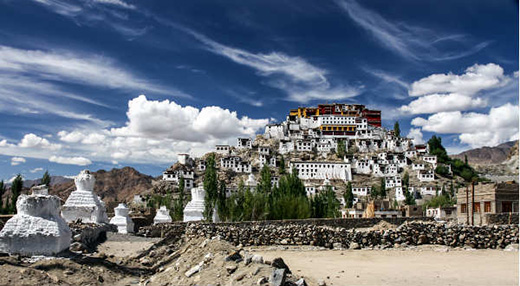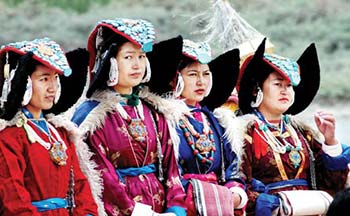Unlike Kashmir, the soon-to-be Union Territory of Ladakh is actively working to consolidate the gains that came to the arid region in wake of scrapping of special status and bifurcation of Jammu and Kashmir. It has finally found a way out to protect its land and demography, reports Masood Hussain

Instantly, the new Union Territory (UT) of Ladakh has gone newsy, both from within and outside. While a 3-member penal is assessing the twin-district’s asset share from the bifurcated state of Jammu and Kashmir, a report suggested a face-off between the rival armies of China and India at the Line of Actual Control (LAoC) somewhere near the PangongTso Lake.
The two countries are staking claims over a vast 130-kms plus stretch that extends towards the Chinese Tibet, the report said. The face-off was managed through talks at the local commander level. The crisis spot was the same where they had a scuffle earlier when the two armies had problems in Doklam. The face-off came days ahead of the October war-games exerciseHimVijay. The exercise, reports said, will take place in Arunachal Pradesh envisaging IAF and the army creating a “real war scenario” within the Indian Territory.
But the real developments are taking place to address the concerns that emanated from the rollback of the special status of Jammu and Kashmir that opened apparently withdrew the protection to demography and land. Ladakh had voiced its concerns seriously. Unlike Leh, Kargil went into an instant strike. There were protests as well. Finally, the governor Satya Pal Malik flew to Kargil, met the local leaders and assured them that their concerns will be taken care of. His visit came days after a section of the political workers formally joined the BharatiyaJanata Party (BJP) in Delhi.
“The markets are open, so are the schools,” one Kashmiri, who is serving in Kargil said. “It is perfectly normal.” The landlines and the mobiles have been unblocked and the internet services were restored. However, in the last few days, Kargil is again facing internet clampdown, the reasons for which are not immediately known. No such situation, however, emerged in Leh. The Buddhist district welcomed the UT move and celebrated the new status. The UT will be operational from October 31, when a Lieutenant Governor will be appointed for the region. However, the Ladakh UT will lack an assembly.
In order to address the concerns of Ladakh, the Government of India has taken an interestingly different route. Reports appearing in the media suggest that the Ladakh UT is being declared a Scheduled Tribe (ST) that will automatically protect its land, culture and demography.
The National Commission for Scheduled Tribes, the Home Ministry, Law Ministry and the Tribal Affairs Ministry have agreed to make Ladakh a tribal area. At a high level meeting the ministries have discussed the idea in the backdrop of the Fifth and Sixth Schedule of the Constitution of India. The Sixth Schedule of the Constitution calls for the administration of autonomous districts and regional councils for the tribal areas of Assam, Meghalaya, Tripura and Mizoram after the formation of autonomous districts. The government has indicated that even after the reorganization, the two Union Territories will have the same High Court.
According to Article 244 and the Sixth Schedule, tribal-dominated areas in four States – Assam, Meghalaya, Tripura and Mizoram – are called “tribal areas”, which are technically different from the “scheduled areas” under the Fifth Schedule. While executive powers of the Union extend in scheduled areas with respect to their administration in the Fifth Schedule, the Sixth Schedule areas remain within the executive authority of the state. At the conclusion of the exercise the Commission on September 11, finally made the recommendation that Ladakh should be declared a ‘tribal area’ in the Sixth Schedule of the Constitution of India.
The inclusion, according to the Commission, as reported by Indian Express, will help in “democratic devolution of powers, preserve and promote distinct culture of the region, protect agrarian rights including right on land and enhance transfer of funds for speedy development of the region.”
The possible recommendation is the outcome of a memorandum that Ladakh BJP had submitted to the Tribal Affairs Ministry earlier. In the memorandum, BJP MP JamyangTseringNamgyal, had said the region is a predominantly tribal area with tribal’s making up to 98 per cent of its population. Seeking the protection, Ladakh Autonomous Hill Development Council Chairman Gyal P Wangyal had also insisted that “now our only demand is that Ladakh be brought under the Sixth Schedule so that their land remains protected”.
LAHDC sent a 4-member delegation to Shillong for four days, last week, to study the set of rights provided to the tribal’s of Meghalaya under the Sixth Schedule. Leh’s former lawmaker TseringSamphel led the delegation. At the same time, almost unofficially, the Himalayan Institute of Alternatives, Ladakh have sponsored five groups to visit Sikkim, Assam, Meghalaya and two UT’s of Andaman and Nicobar and Pondicherry to study the tribal affairs management models in vogue.
Since the UT demand was met, lawyer DeskitAngmo was quoted by The Northeast Today saying that “now it is time for us to look at and study in-depth in respect to the protection of tribal’s, our environment and our lands; to study the Constitution of India and the 6th Schedule that protects and safeguards the tribal’s.” The lawyer, however, wants certain amendments in the Sixth Schedule to suit Ladakh. Once they conclude the exercise, these groups will re-assemble in Delhi, discuss the in-puts and compile their suggestions as a Peoples Document to the Government of India.
Meanwhile, the top officials from Ladakh have fanned to various belts to understand the best UT model that would suit them. A 4-member team led by Leh Municipal Committee President DrIsheyNamgyal was in Kokrajhar, the headquarter town of BTC to study how it is being run. Interestingly, however, in all these efforts Kargil is seemingly missing.
In between there was a sort of a mini-investment summit in Chandigarh on September 6, in which officials and the stakeholders of the Ladakh economy and economics participated. There were many discussions. A senior officer who attended the meeting, however, said the net outcome was not immediately available.
Indicating that by 2025, Ladakh will have completely organic farming, Gyal P Wangyal, the LAHDC Leh Chairman said White Seed Apricot will be the prime focus.
Leh, unlike Kargil, has remained quite sensitive towards any kind of investment from outside. It has literally banished one agricultural entrepreneur in recent past fearing the investor may create his own stakes in local society and economy at the cost of the local rights. The region has not, for a very long time, sold any raw Pashmina wool to the Kashmiri traders. Most of the Pashmina that is used in the making of famed Kashmir shawl is imported from Mongolia.
However, local intellectuals are working on certain niche things that suit the local ecology and the market. “What we want to do is to get into plants that have economical worth and ecological advantages,” SonamWangchuk, the Rolex and Megsasay Award winner who is Ladakh’s most known face said, days ahead of the creation of UT. “The plants like Dry Roses, Capers and Junipers that I am talking about, if grown in higher altitudes will help in absorbing most of the rain water thus they will prevent floods. Indirectly, it will also help manage a gradual discharge thus preventing droughts.”
These plant species grow in high altitude deserts and do not require any irrigation. Dry Rose has enormous commercial use and Capers are fundamental to Pasta, Noodles and other Western dishes. Already there is a movement of using the locally produced Pashmina to create some apparel brand.
While the private investment can wait, the Government of India’s wholly owned Solar Energy Corporation of India (SECI) has started a fast 48-month implementation of a 7500-MW solar power project that would eventually be aRs 50,000 crore 23000-MW Ultra Mega Solar PV project, according to Indian Express. Earlier, the project was to come up at Nyoma but owing to environmental issues, it will now be established at Pang, a spot almost 117 kms from Leh.
The energy generated by the project would be wheeled by a separate transmission line via Manali (Himachal) to Kaithal (Haryana). Earlier, the project had three sections of 2500-MW each at Zanaskar, Taisuru (Kargil) and HanlayKhaldo belt of Nyoma (Leh). Now the entire project will come up at Pang. SECI that would be signing the PPA for 35 years has already issued the Request for Selection of the developers will now start the tendering process, the newspaper reported.
These developments followed the major demand that emanated from Leh within days after the abrogation of the Article 370. It wants exclusion of Ladakh from Jammu and Kashmir and conveying the same to the world. This, they said, was vital to ensure the advisories being issued by the Western world against visiting Jammu and Kashmir should not affect the booming tourism season in Leh.

Ladakh Tourist Trade Alliance actually submitted a memorandum to the visiting Tourism Minister Prahlad Singh Patel. “With Ladakh being a UT, we have been freed from the civil war of Kashmir. We want you to help us create Brand Ladakh,” SonamParvez, an executive of Ladakh Hotel Association requested Patel. They wanted the division to be conveyed first. “Even if there is a small mishap, embassies come out with travel advisories asking their citizens not to visit the area. Our tourism suffers. Please approach embassies on our behalf and tell them that our Ladakh is peaceful.”
The stakeholders also sought the skies to be opened up. They sought a flight each from Bangalore and Ahmadabad. Patel obliged them all and assured the communications will go to all the embassies. He sought a blueprint for a tourism policy that suits the fragile agro-climatic region.
But the biggest boost to the Leh tourism came from Utter Pradesh where the Chief Minister, Yogi Adityanath announced a grant of Rs 20,000 for every Sindhi who wishes to visit Leh and pray at the Indus River. The dole would come from UPs DharmarthKarya, the religious affairs department, according to Times of India. This is aimed at strengthening the SindhuDarshan, a BJP initiated festival that survived the Congress government’s name change in recent years.
“This pilgrimage needs to be promoted as the situation in Jammu and Kashmir and Ladakh has changed now,” the newspaper quoted an official note regarding the initiative saying. “This will help generate employment for locals in that region and SindhuDarshan will be able to play a bigger role than just tourism.”
The concession was already there but the quantum of the dole was doubled in March. UP has a huge Sindhi population that the newspaper put at five million. Once the people start utilising this grant, UP will send tens of thousands of tourists to Leh. The area will have to add to its capacity now.
from Kashmir Life https://ift.tt/2MdGkXN
via IFTTThttps://kashmirlife.net
No comments:
Post a Comment